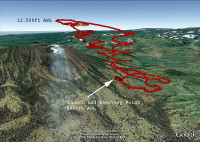NASA researchers modified three repurposed Aerovironment RQ-14 Dragon Eye unmanned aerial vehicles acquired from the United States Marine Corps to study the sulfur dioxide plume of Costa Rica’s Turrialba volcano. The project is designed to improve the remote sensing capability of satellites and computer models of volcanic activity. (Image credit: Google/NASA/Matthew Fladeland)
Home NASA researchers modified three repurposed Aerovironment RQ-14 Dragon Eye unmanned aerial vehicles acquired from the United States Marine Corps to study the sulfur dioxide plume of Costa Rica’s Turrialba volcano. The project is designed to improve the remote sensing capability of satellites and computer models of volcanic activity. (Image credit: Google/NASA/Matthew Fladeland) NASA researchers modified three repurposed Aerovironment RQ-14 Dragon Eye unmanned aerial vehicles acquired from the United States Marine Corps to study the sulfur dioxide plume of Costa Rica's Turrialba volcano. The project is designed to improve the remote sensing capability of satellites and computer models of volcanic activity. (Image credit: Google/NASA/Matthew Fladeland)
NASA researchers modified three repurposed Aerovironment RQ-14 Dragon Eye unmanned aerial vehicles acquired from the United States Marine Corps to study the sulfur dioxide plume of Costa Rica’s Turrialba volcano. The project is designed to improve the remote sensing capability of satellites and computer models of volcanic activity. (Image credit: Google/NASA/Matthew Fladeland)



